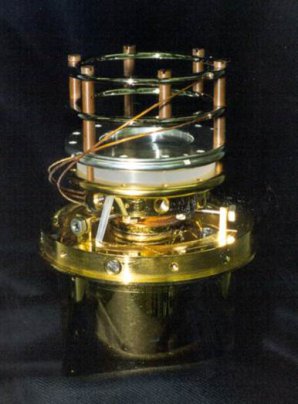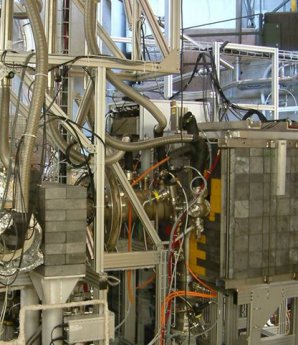Superconductivity can promote magnetization, paving the way to energy-efficient supercomputers
Researchers obtained surprising results when using muons to investigate the relation between superconductivity and magnetization.
27/10/2015

Sample cryostat of the Low-Energy Muon Facility apparatus.
Superconductors, materials that carry electrical current without generating any heat, and magnets are usually incompatible. Researchers were thus surprised when they recently observed that under certain conditions superconductivity actually promotes magnetization in an adjacent normal metal. The results were published in Nature Physics.
Future supercomputers can become more energy-efficient if advances are made in the field of spintronics. However the electron spins are very difficult to control, making it difficult to develop superconducting spintronics devices.
Now an international team of scientists from the UK, Russia and Switzerland, investigated the relation between superconductivity and magnetization in order to understand how to control electron magnetic moments. They used superconducting spin valves, which consisted of two ferromagnetic cobalt layers, one superconducting niobium layer, and a layer of gold. Thanks to muon experiments at the Paul Scherrer Institute (PSI) in Switzerland they could observe how the magnetization proceeds in different layers of the sample. This could be achieved by implanting the muons in the different layers and using the muons’ spins as microscopic magnetometers.

The Low-Energy Muon Facility (LEM) at PSI used for the experiment.
When magnetization directions in two ferromagnetic layers were not parallel, the interaction between these layers and the superconductive layer induced magnetization in the uppermost gold layer. This indicated that the information of the relative alignment of the magnetic layers could be transferred over long distances through the superconducting layer. When the team changed the magnetization directions in two magnetic layers, making them parallel, the effect almost disappeared, the field intensity decreasing by 20-fold.
These observations show that superconductivity can promote magnetization and thus control the electron spin. This paves the way to future energy-efficient supercomputers.
Original Publication
M. G. Flokstra, N. Satchell, J. Kim, G. Burnell, P. J. Curran, S. J. Bending, J. F. K. Cooper, C. J. Kinane, S. Langridge, A. Isidori, N. Pugach, M. Eschrig, H. Luetkens, A. Suter, T. Prokscha & S. L. Lee, Remotely induced magnetism in a normal metal using a superconducting spin-valve, Nature Physics (2015) DOI: 10.1038/nphys3486
Text prepared with materials from Phys.org, a press release from the University of St Andrews and Lomonosov Moscow State University.
M. G. Flokstra and S. L. Lee rom the University of St Andrews in the UK have received NMI3 support to conduct experiments at PSI in Switzerland. The experiments were supported through the NMI3 Access Programme .
Related links
PSI-SINQ cycle I/16: Call for Proposals
The PSI spallation neutron source is accepting beam time requests with deadline on November 15. Read more.
Post-doc position funded by SINE2020 offered at the University of Parma
The Uni. Parma is looking for a Post-Doc with experience in DFT simulations as well as attitude for experimental work at large scale facilities. Read more.
The NMI3 Muon Joint Research Activity
The aim of the Muon JRA is to develop technologies and techniques which extend the range of capabilities of the muon method available to European users at PSI and ISIS. Find out about the latest goals, achievements, and challenges here !
Magnets made of non-magnetic metals
Muons were essential to show how non-magnetic metals become magnetic. The experiments at PSI received NMI3 funding. Read more.





